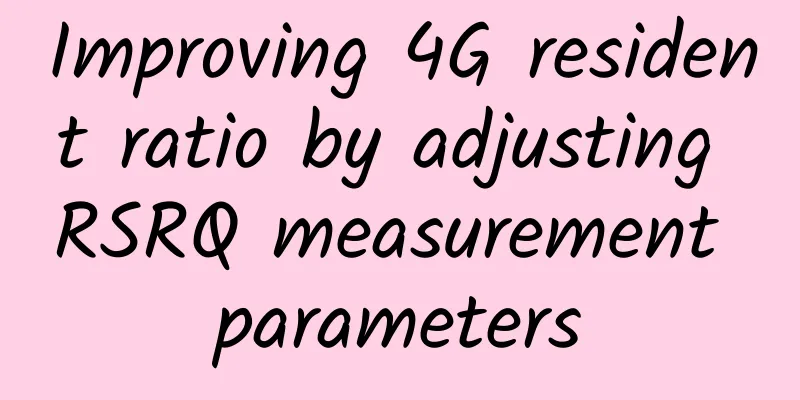Improving 4G resident ratio by adjusting RSRQ measurement parameters

|
Today, when mobile Internet 4G communication has become the mainstream, GSM and WCDMA 2G and 3G networks still bear important responsibilities in various scenarios. However, in the long run, the withdrawal of GSM networks has become a historical necessity. The high-speed transmission advantage of 4G networks determines that both users and operators hope that mobile phones can stay on 4G networks as long as possible. Therefore, network operators are increasingly using 4G retention ratio as an important reference indicator. In order to improve the 4G network residence ratio, the author and his colleagues have made many attempts to adjust the triggering of A2 events based on RSRQ measurement parameters of some base stations in combination with the actual network situation. The comparison of the effects before and after the adjustment verifies that these measures are effective. 1. Background Definition of 4G Retention Ratio: In a broad sense, 4G Retention Ratio refers to the ratio of traffic generated by users holding 4G terminals on the 4G network to the total traffic (2G, 3G, and 4G traffic) generated by them. This indicator measures the retention of 4G users on the 4G network. In actual assessments, we have a clearer definition of "4G users". Definition of 4G users: users who have used 4G network within 60 days. At present, the minimum access level, idle state reselection and redirection mechanism adopted by the existing network are all based on the RSRP reported by the terminal as the only condition for decision-making. However, from the perspective of improving the LTE residence ratio, in many weak coverage scenarios, although the RSRP is very poor, due to the pure wireless environment, the terminal can obtain good user perception even in the LTE weak coverage area, and can still obtain a better download rate than 3G. Therefore, it is proposed to use dual control of RSRQ and RSRP based on measurement redirection, which is more conducive to extending the terminal's residence in the LTE network. 2. Principle Introduction RSRQ (Reference Signal Receiving Quality) stands for LTE reference signal reception quality. This metric is used to rank different LTE candidate cells based on signal quality. This measurement is used as an input for handover and cell reselection decisions. RSRQ implements an efficient way to report the effect of signal strength and interference combined. The relationship between RSRP and RSRQ: RSRQ=N*RSRP/RSSI Remark: N: measurement bandwidth, mapped to the number of RBs RSSI: The average power of all signals (pilot, data, interference, noise) received in the symbol RSRP is the received signal power, in dBm RSRQ (dB) reflects the ratio of the CRS signal to all interference signals, similar to the signal-to-noise ratio 3. Parameter setting strategy The A2+A3 algorithm is used for intra-system inter-frequency switching (1650+500) in LTE system to obtain a better switching link and ensure the road test indicators. This adjustment does not involve intra-system inter-frequency switching. For intra-system inter-frequency switching, the original judgment conditions are still used: A2 event is triggered based on RSRP, A2+A3 judges inter-frequency switching, and A2+B2 judges inter-system redirection. This adjustment is aimed at the situation where there is only LTE1650 continuous coverage and no 500 interlaced coverage. It uses RSRQ-based triggering of A2 events and compares the effects of blind redirection and measurement-based redirection on the residence ratio. ● Comparison between blind redirection and measurement-based redirection Based on RSRQ triggering A2 event, only the source cell RSRQ is used as the only decision criterion for blind redirection. When the UE measures the RSRQ of the source cell ≤ a2ThresholdRsrqPrim and meets the triggering time timeToTriggerA2Prim, blind redirection is triggered. Based on measurement redirection, when the UE measures the RSRQ of the source cell ≤ a2ThresholdRsrqPrim, the A2 event is triggered and the eNB sends the inter-frequency measurement frequency. By setting the current connection state priority from 4/3G to 6/4, the UE measures the 3G frequency and reports the frequency strength of the LTE and W cells. When the source cell satisfies RSRP≤b2Threshold1Rsrp and the 3G cell RSCP≥b2Threshold2RscpUtra, measurement-based redirection is triggered. From the perspective of the two redirection modes, measurement-based redirection through dual control of RSRQ and RSRP is more conducive to extending the terminal's stay in the LTE network. 4. Modify scenes and effects ● Scenario: This adjustment is for the situation where there is only continuous coverage of LTE1650 and no 500 patch coverage. All cells do not include indoor distribution and do not include inter-frequency adjacent cells. ● Effect of modification: After modifying the RSRQ-based redirection, the indicators are stable, the reverse flow ratio is significantly improved, and the business volume is also increased. Comparison of network pulling before and after parameter modification: Access, switching, disconnection KPI, CSFB indicators Backflow ratio, business volume, residence ratio It can be seen that the adjusted backflow ratio represented by red has dropped significantly compared with the pre-adjustment ratio represented by blue, and has no deteriorating effect on other KPI indicators. See the comparison trend chart below for details. 5. Summary and suggestions This adjustment parameter is based on RSRQ as the basis for triggering the A2 threshold, and measurement-based redirection is enabled at the same time. For some areas with weak LTE coverage but good reception quality RSRQ, the A2 event is not triggered, which increases the LTE network's absorption of business volume, obtains better LTE network resident performance, and evaluates the impact of no indicator degradation on daily KPIs. After the parameter adjustment, the local city’s 4G network traffic increased by about 1,400GB per day, an increase of about 7%. ● It is recommended to pay attention to the following points: 1. Parameter adjustment is only applicable to 1650 cells and there are no inter-frequency adjacent cells. 2. After the parameters are modified, it is necessary to pay attention to the fluctuations of KPI and poor quality cells. If there is a deterioration, it is necessary to analyze and adjust in time. |
<<: Chinese companies are strong in 5G R&D, spectrum strategy planning needs to be implemented
>>: Ruijie appeared at GITC: Internet companies please give me a thumbs up!
Recommend
How Next-Generation Data Centers and 5G Can Transform Healthcare
Data centers are breaking free from physical limi...
Acceleration Cloud: Deyang High-Defense Cloud Server 39 yuan/month-dual core/2G memory/60G hard disk/5M bandwidth/100G defense
Acceleration Cloud is a website under Chengdu Xia...
As 5G private network applications enter deep waters, how can we achieve the goal of going from 1 to N?
At present, the 5G competition has entered the se...
DediPath has a 25% discount on the first month, VPS starts at $0.87 for the first month, multiple data centers in Los Angeles/New York, etc.
DediPath has launched a 25% discount promotion fo...
Huawei China Ecosystem Partner Conference 2017 concluded successfully in Changsha
On March 10, 2017, the second day of "Born f...
80% of users face challenges in PoE deployment
Four out of five users experience challenges when...
5G mobile phones start at 8,000 yuan. Use WiFi to experience 5G network first
Terminals that support 5G will be launched in 201...
The dilemma of contemporary 5G users: From being 5G to returning to 4G, we should slow down
If the elderly are the ones abandoned by the Inte...
SoftShellWeb: San Jose/Netherlands VPS monthly payment starts at $3, Taiwan VPS annual payment starts at $49
SoftShellWeb is a foreign hosting company registe...
Gcore (gcorelabs) Hong Kong VPS simple test
A few days ago, we did a simple test of Gcore'...
#Has run away#Limewave: $12.9/year KVM-1GB/15GB SSD/3TB/Seattle data center
【Attention】This merchant has run away!!! Limewave...
The three major operators announced their operating data for May
Recently, the three major operators released thei...
6 IT roles that need retraining
Given the rapid pace of change in the technology ...
Current limiting is never an easy task!
[[354146]] This article is reprinted from the WeC...
2021 China Internet Haha List 2: Top Ten Events
In 2021, the Internet industry has emerged with m...







![[Black Friday] FlipperHost: 2GB memory KVM monthly payment starts at $4.9, 4 data centers in Los Angeles and other places](/upload/images/67cac473c3319.webp)

